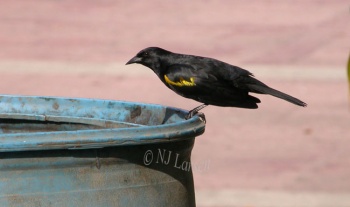- Agelaius xanthomus
Identification
20-23cm (8-9 inches)
The adult is glossy-black with yellow shoulder patches that will always be visible if the bird is flying, but if standing, they can cover or reveal the yellow patch at will.
Immature is duller black and has a brown abdomen.
Similar Species
The Greater Antillean Oriole has more yellow. Greater Antillean Grackle has a longer tail which folds in a V-shape and lacks yellow in the wing. Shiny Cowbird male has a purple sheen and lacks yellow in the wing; the female is not black.
Distribution
Caribbean: endemic to Puerto Rico.
Taxonomy
Subspecies
There are 2 subspecies[1]:
- A. x. monensis:
- Mona Island (off western Puerto Rico)
- A. x. xanthomus
- Lowlands of south-western and north-eastern Puerto Rico - though mainly along the south-western coast.
Habitat
Mainly mangroves and dry scrubland.
Behaviour
Diet
Feeds on insects, seeds and nectar, which it takes both on the ground and in trees.
Breeding
They breed in small colonies, building neests both in crevices and tree forks.
Conservation Concerns
Yellow-shouldered Blackbird has been described as being common in the 1940s, but habitat degradation and nest parasitism from the Shiny Cowbird, which reached Puerto Rico in the 1940s, forced the population down quite dramatically, to a low of about 1000 birds.
The population on Mona Island is less affected by the cowbird because they often nest in cliff crevices which the cowbird does not visit.
References
- Clements, J. F., T. S. Schulenberg, M. J. Iliff, D. Roberson, T. A. Fredericks, B. L. Sullivan, and C. L. Wood. 2018. The eBird/Clements checklist of birds of the world: v2018. Downloaded from http://www.birds.cornell.edu/clementschecklist/download/
- Handbook of the Birds of the World Alive (retrieved November 2016)
Recommended Citation
- BirdForum Opus contributors. (2024) Yellow-shouldered Blackbird. In: BirdForum, the forum for wild birds and birding. Retrieved 27 April 2024 from https://www.birdforum.net/opus/Yellow-shouldered_Blackbird





